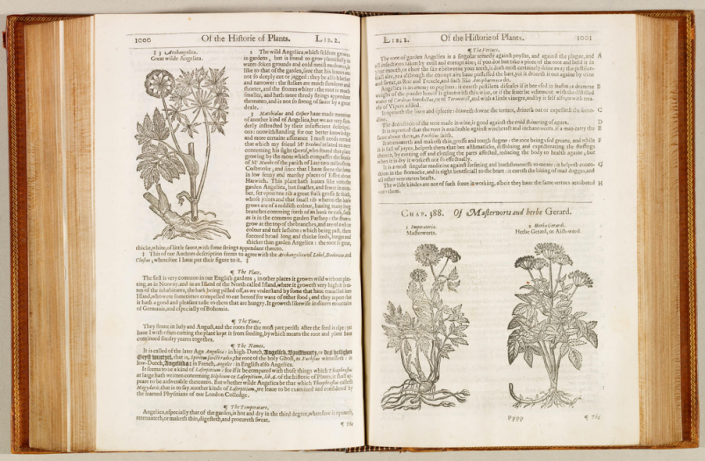The Herball or Generall historie of plantes by John Gerard (1545-1612) was first published in London in 1597 by Adam Islip, Joyce Norton and Richard Whitakers. Gerard was an English herbalist and the curator of the physic garden of the Royal College of Physicians, London. He is traditionally considered to be the “father of Botany”.[1] The Herball features more than 1,000 species and 2,766 woodcut illustrations in total, and Gerard organised this content by breaking it down& into three books.[2] The first book includes grasses, rushes, corn, reeds and bulbous plants. The second includes herbs used for cookery, medicine or perfumery, and the third book includes shrubs, bushes, fruit bearing plants, rosins, roses, heaths, mosses, mushrooms and coral. For each species of plant, he lists the different types, with illustrative pictures, textual descriptions of appearance, information on the places in which they grow, their growing seasons, their different names, natures, and virtues.
Due to its popularity–and also on account of some mistakes (such as mismatching illustrations)–it was re-edited by the London apothecary Thomas Johnson in the 1630s. The new enlarged second edition was published in 1633, followed by a third edition in 1636.[3] These editions contained additional material, such as an introduction by the royal chief surgeon George Baker, poems commemorating Gerard’s contribution to botany, and a catalogue of the newly added species. This book was published in English, which suggests that it was intended to be used in homes by non-specialist readers, as well as by physicians. This was part of a larger trend: an increase in the vernacular publishing in the sixteenth century had made more books accessible to people who were not able to read Latin. Interestingly, Gerard included the names of plants in a number of European languages too, such as Latin, Greek and French, which enabled the share of medical information across Europe.[4]
The importance of the Herball among medical professionals is shown by some of the previous owners of this book, such as the English physician Edward Holme (1770-1847), whose copy is now in the Special Collections of University College London.[5] In this copy, the names of certain plant species have been updated by hand throughout, which suggests that it was well used, either by Holme or a previous owner.
References
[1] Marja Smolenaars, ‘Gerard, John (c. 1545- 1612), herbalist’, (Oxford Dictionary of National Biography, 2008) <https://doi.org/10.1093/ref:odnb/10555> accessed 8 April 2020.
[2] H. S. Bennett, English Books and Readers 1603-1640: Being a Study in the History of the Book Trade in the Reign of James I and Charles I (Cambridge: Cambridge University Press, 1990), 147.
[3] Deborah E. Harkness, The Jewel House: Elizabethan London and the Scientific Revolution (New Haven: Yale University Press, 2007), 55.
[4] Elaine Leong, ‘Herbals she peruseth’: Reading Medicine in Early Modern England’ in Renaissance Studies, Vol 28, Issue 4, (Journal of the Society for Renaissance Studies, John Wiley & Sons Ltd, 2004), 565.
[5] John Gerard, The Herball or Generall Historie of Plantes (London: Adam Islip, Joice Norton, 1636), <https://ucl-new-primo.hosted.exlibrisgroup.com/permalink/f/5qfvbu/UCL_LMS_DS21157496880004761> accessed 8 April 2020.

Image: The Herball, or, Generall historie of plantes 1636, ©Royal Collection Trust 2015